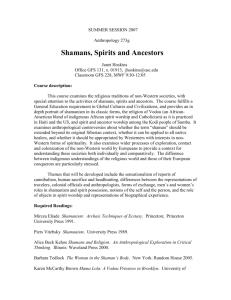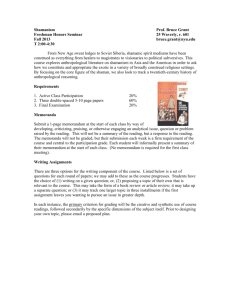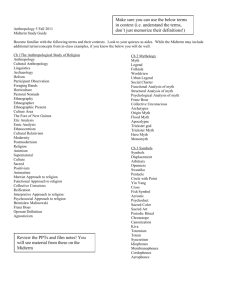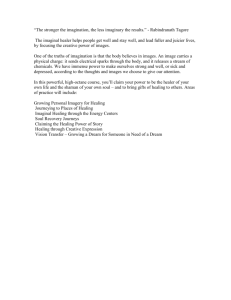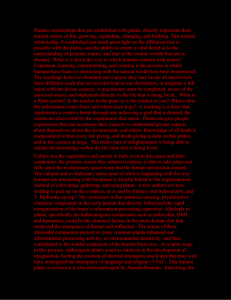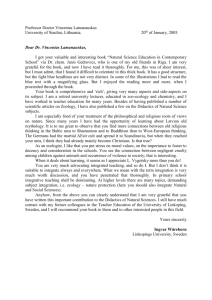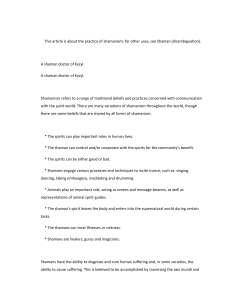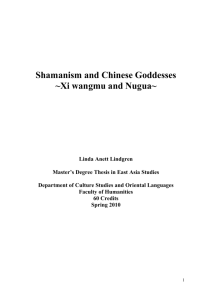Shamanism and Modern Day Psvchotherapy
advertisement
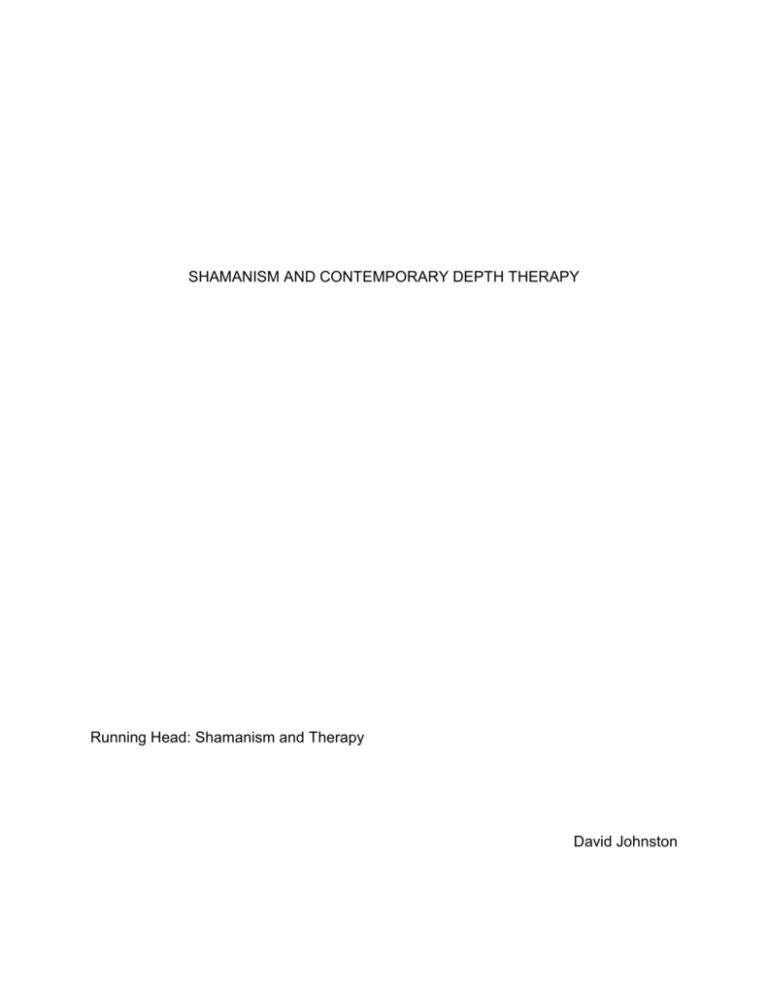
SHAMANISM AND CONTEMPORARY DEPTH THERAPY Running Head: Shamanism and Therapy David Johnston Shamanism and Therapy 2 ABSTRACT In this essay I discuss the nature of Shamanism and its relevance for depth-therapy. Contemporary therapists can learn much from the shamanic model. Indeed, there are many parallels between shamanism and depth psychology. Yet, one must always take into consideration the individualistic nature of the contemporary person and, in some cases, the activation of the instinct for individuation. Shamanism and Therapy 3 SHAMANISM AND CONTEMPORARY DEPTH THERAPY Introduction “Shamanism equals technique of ecstasy,” and shamans are both master technicians and specialists in the human soul (Eliade, 1974). As the dominant figure in the religious life of magico-religious society, they are the link to the sacred and meaning (Kakar, 1983). Although the individual who fills this role may have many other functions, as a shaman, the principal occupation is that of healer (Eliade, 1974). Shamanism is an archaic practice with shrouded beginnings, dating back to Neolithic and even Paleolithic times (Halifax, 1979). It is rooted in the dawn of consciousness, when humankind was emerging from being sleepily embedded in nature. At that time, all life was sacred and magico-religious rites were performed to gain mastery over existence (Gebser, 1984). The general consensus of expert opinion holds that shamanism, as we know it today, is decadent (Eliade, 1974). Moreover since, what may be called, the golden age of shamanism there has been an evolution of consciousness (Gebser, 1984). By and large, humankind no longer lives in a magico-religious world, with its ritual, sacred hearing and divine revelation. We have since passed through the age of mythology, with its emphasis on seeing and inner vision, along with its cults of gods and goddesses. Although seeds have been planted for an integral consciousness, we still live in the mental age where the intellect and dissecting reason reign supreme. Initially guided by intuitive insight, reason now rules through science and technology and is driven by the will to power (Barrett, 1979). The mystery of magic and the art of Shamanism and Therapy 4 mythology have degenerated to popular entertainment and manipulative advertising; the shaman has become the media and the gods and goddesses reside in our complexes. I make these observations notwithstanding the phenomenon of contemporary India, where all these levels of consciousness still exist in a vibrant reality, although at time uneasily. The question is, “can modern day psychotherapy learn anything from Shamanism and the shaman's way of working?” . The quick answer is yes and no. There is one major qualification. The contemporary psyche must be accepted and attended to as is. Generally speaking, today, the individual is restless and driven. There is little sense of the sacred and no mythological dimensions of life, and little concern for intuitive reason. Moreover, there is no relatedness and no sense of the “knowing and feeling with” of Eros, essential for connection to magical and mythological reality. Instead, the individual's world is constructed by a fragile outward looking ego, separated from the unconscious and the whole. Along with this, there is goal directedness and the ideal of autonomy and freedom of choice. Depth-psychologists must begin where the analysand is and follow the spiraling thread of psyche, wherever it may lead. One begins with the contemporary autonomous person, acknowledging that the magicoreligious world of the shaman is lost in a distant time and space. Today, this generally means working backwards to recapture humanity's phylogenic stages of growth. Often the need is to educate the intuition and relatedness to the image in a conscious return to the mythological perspective (Hillman, 1975). Shamanism and Therapy 5 Shamanism and Depth Therapy: Parallels and Lessons The commonly accepted word for the archaic healer is shaman, derived from the Tungusic saman and the Manchu saman, meaning one who is excited, elevated (Kakar, 1983). The word may be derived from the sanskrit sram meaning to heal oneself, or to practice austerities (Halifax, 1979). There are a number of other sanskrit words which may shed more light on the nature of shamanism and its approach to healing. For example, the word sravs from the root sru means to hear, gathering and reflection, säma means self-government and samadhi, ecstatic trance (Anonymous, 1972) (Sri Aurobindo, 1971). Indeed, shamans are master technicians who enter into a trance and leave the body at will (Eliade, 1974). This is a basic aspect of their approach to healing. They are “master[s] of fire” with a relationship to actual heat and fire that transcends the normal human condition (Eliade, 1974). Wisdom comes through hearing and revelation, and the cure often coincides with receiving the word, the mantra or song (Halifax, 1979). Finally, there is experience of inner light and the fire of truth, at least in some cases (Eliade, 1974). Perhaps, rather than “master of fire”, in its original meaning, inasmuch as they are identified with the fire, shamans are, above all, “priest(s) of the sacrifice”, where “no sacrifice is possible without Agni ... the flame on the altar and the priest of the oblation” (Aurobindo, 1972, p. 359). As “priest[s] of the sacrifice”, shamans are central to the sacred ritual necessary for healing. Their lineage can be traced back to the original ancestor, the archetypal Shamanism and Therapy 6 shaman and primordial healer Eliade, 1974). Moreover, in addition to an ancestral guardian spirit and tutelary [animal] spirit, other helping spirits are invoked (Eliade, 1974). The depth therapist is also a healer, a therapeutes or priest attending the cult of psyche, likewise at the service of the archetypal powers of healing and the divine healer (Meier, 1967). Both shaman and depth therapist are instruments for healing. Shamanism teaches that all life is sacred. It teaches that therapists themselves are not healers but “priest[s] of the sacrifice.” The archetype of the healer, which both transcends and relates to the immanence of the psyche, does the actual healing. Finally, shamanism teaches the need for self-government and attention to the voice of the archetype. Contemporary depth-therapists can do this by relating to their own dreams and active imagination as well as, during the therapy session itself, attending to the inner voices and images of the psyche, both their own and those of the analysand. Shamans are “wounded healers”, and suffer severe initiatory trials during experiences of psycho-spiritual death and resurrection (Eliade, 1974). They are wounded, manifesting apparently pathological states of mind before emerging whole (Eliade, 1974). These experiences, along with instruction on healing and tribal cosmology and ideology by practicing shamans, prepare the initiate for acceptance by the community and a vocation as a healer (Eliade, 1974). Moreover, it seems that there is often specialization in the kinds of illnesses that shamans cure that relate to their own wounds. Shamanism and Therapy 7 Thus, there are further lessons to learn. Contemporary aspirants to become depththerapists require depth-therapy to uncover and heal their own wounds in order to become “wounded healers.” As Hillman (1975) argues, pathology is the locus for healing, indicating the necessity of becoming more conscious of one’s pathologies like the shaman. The objective and collective nature of the psyche suggests that, at some level, connected to the wounds of the client are those of the therapist. In addition, there is a need to complement inner healing with instruction in healing practices, the cultural and mythological foundations of the Western and North American psyche and the dynamics of the present zeitgeist. There is also a need to gain the confidence and acceptance of the community. Today some form of officially recognized accreditation and “word of mouth” serves this purpose. The shaman is directly related to both the blacksmith and potter, all three of whom are “masters of fire” (Eliade, 1978). The alchemist, another “master of fire” emerged from the cult of the blacksmith with its secret societies and rites of initiation (Eliade, 1978). As Jung (1977) amply demonstrates, alchemical symbols dramatically reflect the unconscious of the present-day individuating psyche. Shamanism, itself and related symbols also touch a profound chord in the collective unconscious and provide examples of powerful archaic images for the modern healer. The images that make up the shaman's symbolic world all find a deep resonance in the collective psyche today. They include: death, dismemberment, the skeleton, regeneration and re-memberment through the growth of new skin, the insertion of Shamanism and Therapy 8 crystals, iron, etc., resurrection, the cosmic tree, the ladder, the cosmic mountain, the ritual ascent and descent, holes in the sky and earth, clashing gates, fire, magical flight, the seven (7) etc. levels of being, the drum made from the cosmic tree and animal hide of the tutelary spirit, the multiplicity of souls, the tutelary (animal) spirit, the guardian or ancestral spirit, the intruding spirit, symbol of the archetypal shaman, androgyny, soft men and warrior women, fullness of time, etc. Shamanism like alchemy, its near relative, is a master teacher and provides rich amplificatory material, which helps one in relating to contemporary dreams and visions. During the healing ritual, shamans confront the demons of sickness even at times traveling to the “land of the dead” (Jilek, 1982) (Sullivan, 1989). They do so in order to return the patient’s “lost soul”, or “guardian spirit” which has wandered as a result of the individual having broken a taboo. Or, they confront an intruding spirit or subtle object lodged there either accidentally or through black magic (Sullivan, 1989). Although the actual healing is done by the archetype of the healer, the individual shaman goes through considerable peril against which there is a need for ritual protection. There are, again, several parallels with depth psychology. Firstly, contemporary therapists, too, are affected by the “sickness” in the analysand’s soul. The healing process often requires a direct engagement with the pathological psyche, which they share with their client at a deeper level. This can amount to a descent into the collective unconscious in search of healing awareness. The therapist, like the shaman, Shamanism and Therapy 9 needs some form of protection that come primarily through having values, such as integrity and sincerity along with constant attention to the unconscious. Secondly, the “loss of soul” and experience of the alchemical nigredo and “dark night of the soul” are a common experience of individuation (Jung, 1977). Here again, shamanism can provide amplificatory material for contemporary therapists. Thirdly, sickness through breaking a cultural taboo is a common source of neurosis, where cure requires a more conscious relationship to ethical and social values. Shamanism helps place this phenomenon in perspective. Finally, we are now aware of the fact that spirit possession, black magic and “devil worship” exist. For most therapists it may be necessary to turn to an exorcist or shaman for help. Acknowledging this is the teaching. In addition, spirit possession can, in some instances, be compared to inflation caused by identification of the ego with an archetype or a psychosis, which amounts to the absorption of the ego by an archetype. Space limitations do not allow me to delve too deeply into the outer ritual and workings of shamanism. Suffice it to say that, in itself, it helps to create a powerful atmosphere that can only aid in the healing process. The use of power paraphernalia, the shamanic costume, masks, vivid colours, drumming, blowing, sucking, chanting, dancing, the use of incense and so on, all taken, together, create a powerful healing impression on the psyche of the ailing patient. For one thing, shamans confront the patient with symbolic images and a hypnotic rhythm, which engages the psyche at the level of the archetypal unconscious. It can potentially transport the individual back to a connection with the Shamanism and Therapy 10 “mythical time of origin” and a sense of wholeness, and consequently, induce a cathartic response. Given the more individualistic turn of the contemporary mind, connection to the archetypal world is self-directed through such activities as sandplay therapy, art therapy, and more intensely, some form of active imagination. Otherwise, the depththerapist can facilitate healing, in the shamanic sense, by a careful choice of office and its appointments. Paintings, other art objects and decorations can be selected which appeal to a deeper archetypal reality. In the shamanic tradition, there is ego support through family and community participation, which also undoubtedly has a healing effect on the community, if not only the extended family. If nothing else, their support provides a marvelous container for catharsis and the reintegration of the ailing person back into the community (Jilek, 1982). In this regard, systemic forms of family therapy take a similar approach, at least at the level of the family. The therapist doing individual therapy can learn from the shamanic model that, at times, there is value for family participation as well or, at the least, the spouse or partner in the case of an adult. Contemporary healing, in the true sense, does not mean removal of the symptom, but discovery of consciousness and meaning in life (Meier, 1967). In the second half of life it means becoming conscious of the religious function, the ability to reflect back upon oneself, the archetypal unconscious, the numinous and synchronicity. Healing means Shamanism and Therapy 11 discovering, for the “first time,” that all life is sacred. Thus, the world of the depth therapist meets that of the shaman. But, there is a difference. In the world of shamanism, shamans become conscious, and perhaps not even they do, at least in the decadent shamanism of today. They don't, that is, inasmuch as there is a limited relationship between inner experiences and daily life (Jilek, 1982). Life is considered to be sacred and whole for many contemporary shamans, but conservatism restrains the individual development of consciousness-life and individuation. Conclusions With all their one-sidedness, the contemporary person has a sense of autonomy and individual personality, however illusory. Although healing involves becoming conscious of the religious function, the instinct of individuation puts some people on a complex path that involves consciously recapturing many levels of being. Whereas the shaman is active and the patient, relatively passive, in contemporary therapy the therapist listens responsively and attends while, over time, the analysand becomes increasingly actively engaged. Through active imagination and reflecting on one’s dreams, there is a developing sense of uniqueness of personality, of more conscious wholeness. The difference today is this instinct for more conscious individuation. Depth-therapy can learn much from the way of shamanism, but along with the more individualistic nature of the modern mind, this crucial difference must be accounted for. Shamanism and Therapy 12 REFERENCES Anonymous (1969). A glossary of sanskirt terms in synthesis of yoga (pp. 57, 65. Pondicherry: Sri Aurobindo Ashram. Aurobindo, Sri (1971). Sri Aurobindo Birth Centenary Library. Popular Edition. Volume 10. The secret of the vedas (p. 359). Pondicherry: Sri Aurobindo Ashram. Aurobindo, Sri (1971). Sri Aurobindo Birth Centenary Library. Popular Edition. Volume 11. Hymns to the mystic fire. (p. 16). Pondicherry: Sri Aurobindo Ashram. Barrett, William (1979). The illusion of technique (pp. 224-242). Garden City, New York: Doubleday & Company, Inc. C. G. Jung (1977). The Collected Works of C. G. Jung. Volume 12. Psychology and alchemy (R. F. C. Hull, Trans.). Bollingen Series XX. Princeton: Princeton University Press (original works published, 1944 and 1952). Eliade, Mircea (1974). Shamanism: Archaic techniques of ecstasy. (Willard R. Trask, Trans.). Bollingen Series LXXVI, (pp. XIX, 1-91, 112-130, 205-250, 401, 475, 500-510). Princeton: Princeton University Press. (original work published 1951). Eliade, Mircea (1978). The forge and the crucible: The origins and structures of alchemy (2nd ed.). (pp. 79-81, 184). (Stephen Corrin, Trans.). Chicago: The University of Chicago Press (original work published, 1956). Gebser Jean (1984). The ever present origin (pp. 1-102). Athens: Ohio University Press. (original work published 1949 and 1953). Halifax, Joan (1979). Shamanic voices: A survey of visionary narratives (pp. 3, 4, 33). New York: E. P. Dutton. Hillman, James (1975). Re-visioning psychology (pp. 1-112). New York: Harper & Row, Publishers. Hultkrantze, Ake (189). Health Religion and Medicine in Native American Traditions. Lawrence E. Sullivan (ed.). Healing and restoring: “Health and medicine in the world’s religious traditions.” (pp. 327-334). New York: MacMillan Publishing Company. Jilek, Wolfgang (1982). Indian healing: Shamanic ceremonialism in the pacific north west today. (pp. 123, 138-155). Washington: Hancock House Publishers, Ltd. Kakar, Sudhir (1983). Shamans mystics and doctors: A psychological inquiry into india and its healing traditions. (pp. 89-90). Boston: Beacon Press. Meier, C.A. (1967). Ancient incubation and modern psychotherapy. (Monica Curtin, Trans.) (pp. 1-8, 127-139.) Evanston: North Western University Press. (original work published, 1949).
